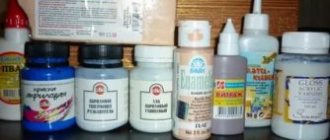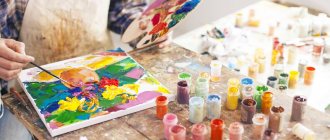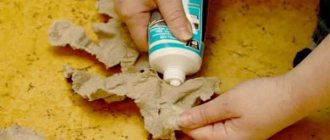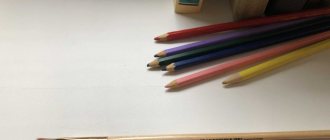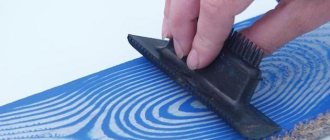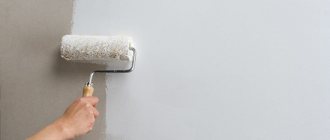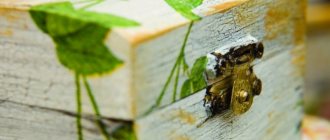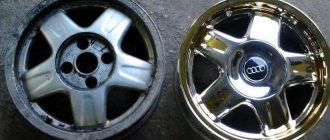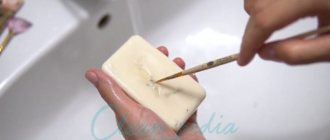What types of brushes are there?
Modern girls' makeup bags can contain a wide variety of brushes: from one to forty or more, if we are talking about a professional makeup artist. Why so much? The point is not only that for some people a couple of basic tools are enough, while others are used to working on their makeup at a more serious level - it’s just that brushes are divided into groups according to various criteria, so it’s sometimes difficult to choose just one it can be difficult.
Application area
First of all, brushes are divided based on the area of use:
- for the skin (working with foundations, powders, blushes, highlighters, bronzers and concealers);
- for eyes (shadow and eyeliner);
- for eyebrows;
- for lips (applying lipsticks, glosses).
Composition of makeup brushes
In addition to the area of responsibility of each brush, it is important to pay attention to its composition: makeup brushes can be natural or artificial. Each material is good in something of its own; they all have their own advantages and disadvantages.
Natural brushes consist of the hair of a variety of animals: these can be hairs from squirrels, goats, horses, martens and measles with softer bristles, as well as pork, badger and buffalo with harder bristles.
The good thing about such tools is that, due to the natural cuticle, the cosmetic product is picked up onto the brush much easier, the pigments are well absorbed into the hairs and blended over the skin. Beginners are recommended to use them, since it is much more difficult to overdo it with applying cosmetics, so they are just right for practice. Natural brushes are especially good for applying powder.
The artificial bristles in brushes consist of synthetic materials such as nylon of varying hardness. They are more dense, they are easier to wash, and products with a liquid texture are not absorbed as strongly as natural ones - this means that less amount of cosmetics will be spent on makeup.
Some brands mark their brushes with colors, making it easier to choose the right tool. For example, beige shades mean working with the base, while brighter shades mean working with the eyes or lips.
Brush shapes
You've probably noticed how different brushes can be: round, fan-shaped, beveled and many others. This parameter influences the choice no less than the others: depending on the area where the cosmetic product is applied, the shape of the brush itself is selected - this is necessary in order to apply makeup as carefully as possible.
The following main types of brushes are distinguished:
- smooth;
- petal-shaped;
- beveled or diagonal;
- bunch-shaped with different lengths;
- fan-shaped;
- barrel-shaped.
It is important to understand that even one area can be treated with different brushes: for example, it is generally accepted that concealer is best applied using a flat brush made of natural materials, but try using a combined tool that contains two types of bristles - this will make the brush fluffy, so shading will be more successful.
Use angled shapes for a more graphic application, as they apply color better, and brushes with rounded outlines are for blush, powder or eye shadow that needs to be carefully blended.
Treasure from China
In Ancient China, paper, brush, ink and ink were called “the four jewels that are in the chambers of a cultured person.” For each of these things a special canon was established. All because it was in this country that the art of calligraphy received incredible development. In China, this art is called philosophical teaching and is compared to qigong. Well, what is calligraphy without brushes? The oldest calligraphic brush that has come down to us dates back to the Warring States period (403-221 BC). Since that time, the brush has changed its shape many times. Classic Chinese brushes, used in calligraphy and Guohua painting, are intended for working with ink and mineral paints. Depending on their purpose, each has a different appearance and structure of the pile. Although any calligraphy brush uses only natural bristles. The raw material for creating a brush is goat or hare hair. Their wool perfectly absorbs liquid and retains it in sufficient quantities. It is important that the brush has a pointed tip, neat hairs, a round shape and enviable elasticity. A classic brush is made only by hand. Its production consists of 70 stages, depending on the style of writing or painting. In the Chinese tradition, there are more than 200 varieties of this instrument. In earlier times, brush handles were made only from natural or precious materials. There are brushes with handles made of jade, silver, sandalwood, bamboo, ivory, bull horn, etc. It is believed that a beautiful brush helps an artist or scribe gain inspiration. From this it becomes clear why the Chinese called such brushes treasures. Today, it is not difficult to purchase a professional calligraphy brush in China, but the classic ones are still very expensive.
Face brushes
It is a mistake to believe that there should not be many brushes for applying products to the skin of the face - some girls are completely limited to one. It is better if each type of task has its own brush with certain characteristics that will simplify working with the face: a flat synthetic one for tone, a fluffy one for blush and powder. This is a base that you can’t do without, but in reality there can be a lot more face brushes.
Foundation
For professional application of foundation and other corrective products, you can use different types of brushes:
- contour , which looks like a trimmed barrel-shaped brush, is great for drawing wide lines when contouring and sculpting;
- a long flat one , in which the tuft has a rounded shape and an artificial composition - due to this, the foundation is not wasted as much as when using natural bristles. The brush is small, so it is good for working on the area of the eyes and lips;
- spatula brush , which is present in many girls’ cosmetic bags. Its peculiarity is that even the most unruly foundation is “driven” into the skin easily and efficiently.
Concealer
Concealer brushes are similar to those used for foundation, but are smaller in size. A short, flat brush with artificial bristles helps you apply the product precisely and blend it out. It is used to correct problem areas with liquid correctors, which are so difficult to shade due to their dense textures.
Powder
Brushes for shading powder should be chosen exclusively from natural materials - they cope with the task as best as possible. The brush should be moderately wide, so that it is easy to pick up a large amount of product. A brush for powder textures can be of the following types:
- kabuki , which works with compressed media. It looks like a dense ball of natural hair, where each hair is very close to the other;
- fan , which, thanks to its wide fan-shaped shape, easily applies the product and removes excess from the face. The hairs in it are not very close to each other.
Blush
The brush for distributing blush is selected depending on the texture of the product. For dry ones, a tool with natural bristles, slightly smaller in size than a powder brush, is suitable. This size and shape are due to the fact that the product is applied locally - on the apples of the cheeks and cheekbones. To make it more convenient to apply, a beveled edge is added to the brush. If you prefer creamy blush, then you need to choose from artificial brushes that will not take up too much cosmetic product - it’s much more economical, and it’s harder to overdo it.
To contour with blush, use a flat brush with an even cut. She can blend the blush much more carefully, just remember to choose shades in the gray-brown range. With such a brush it is much easier to emphasize the lines: chin, cheekbones, nose.
What is a kabuki brush and what is it used for?
Sometimes we can feel like real artists using a whole arsenal of brushes in our beauty routine. But it’s easy to get confused about them; it will take a decent amount of time to understand which ones are really necessary for daily makeup, and which ones are optional. In this article we will talk about an unusual but extremely useful accessory.
What is a kabuki brush
The kabuki brush is visually very different from the others: a short and wide handle, which can be either streamlined or pointed (it all depends on the imagination of the manufacturer) + lush and thick bristles, which are also available in different options: natural, artificial, natural shade or painted.
Why is the kabuki brush called that?
The kabuki brush got its name back in the eighteenth century from the national Japanese theater of the same name. The actors used an unusually shaped brush for a reason: it helped to apply the powder perfectly finely, while making the makeup visually dense.
SHU UEMURA Brush Petal 55 collection ONITSUKA
L'ETOILE Kabuki brush for applying makeup in marble design
What is a kabuki brush used for?
This brush can perform a whole range of tasks depending on the shape and density of the bristles.
- To create an even coating, you can use a thick natural brush. The accessory helps to “seal” the product into the skin, so the tone applies quite softly.
- To apply blush, choose a pointed, fluffy one. This accessory will allow you not to overdo the intensity of the product on the skin.
- A kabuki faux bristle brush works great with correctors and concealers. With the help of such a duet you can easily hide imperfections.
NARS Kabuki Botan Brush
SHISEIDO Camellia brush for powder textures HANATSUBAKI HAKE
Experts note the versatility of the accessory: if you find a comfortable brush, it can be useful when using many products.
DOLCE&GABBANA Transformable kabuki brush for foundation
KARL LAGERFELD & MODELCO Kabuki makeup brush COLLECTABLE KARL BUKI BRUSH
How to choose the right kabuki brush
- Pay attention to the density of the pile. If you want to achieve light coverage, choose a fluffy brush, and vice versa.
- The bristles should not fall out - this applies to brushes made from both natural and artificial materials.
- All fibers should be trimmed evenly; there should be no sharp corners, unless the shape suggests so.
- The brush should be elastic - this means that the villi, after pressing, return to their original place, and when applying the product, they do not scratch the skin.
- Also pay attention to the “leg” of the product; it should be comfortable for you to hold the accessory in your hand.
DECO. Kabuki brush TROPIC STORM
ESMI SKIN MINERALS Kabuki face brush for applying powder
Don't forget that you need to care for your kabuki brush in the same way as other brushes: use a special detergent or gentle shampoo to clean it and do not dry it vertically. Be beautiful!
Cover photo: @muaawesome .
Eye makeup brushes
For eye makeup, use brushes made of artificial fibers. To apply shadows we use a rounded flat shape. These brushes help to better apply the pigment and prepare it for blending. Choose medium-sized, slightly fluffy brushes.
We carry out shading using a round barrel brush - this is the second mandatory tool that is needed for eye makeup. With it, the color will be distributed evenly over the eyelid, and the fold above the upper eyelid can be easily highlighted - this way you can make your look more expressive. In order to add accents to your makeup, you should use an oblique shape.
Eyeliner can also be applied using a special tool. This should be a round, thin brush made of synthetic material that will help create neat, thin arrows using liquid products. Choose brushes of medium and high hardness - this way you can make the lines thin and graphic.
The force of pressure on the brush affects the thickness of the arrows - this also needs to be remembered.
We recommend purchasing several different eyeliner brushes at once - experiment with shapes and hardness to get different eye makeup results.
